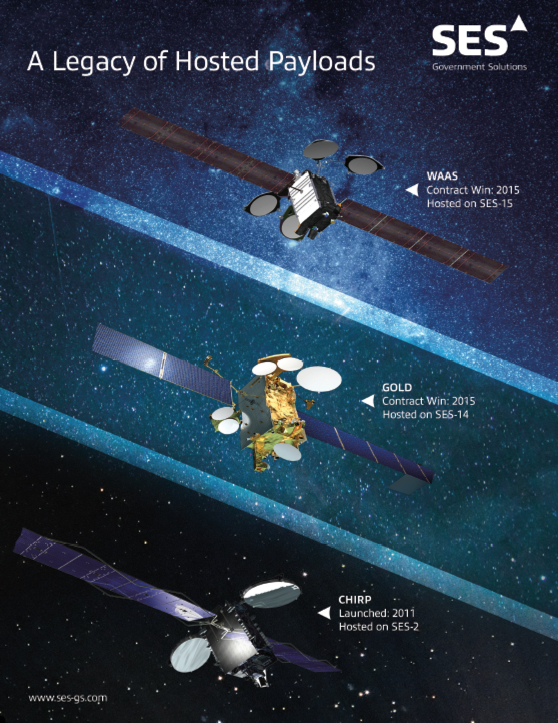Throughout the space age, there have been many proposals for single-stage-to-orbit (SSTO) horizontal-takeoff-horizontal-landing launch vehicles that would make spaceflight similar to aircraft flights.
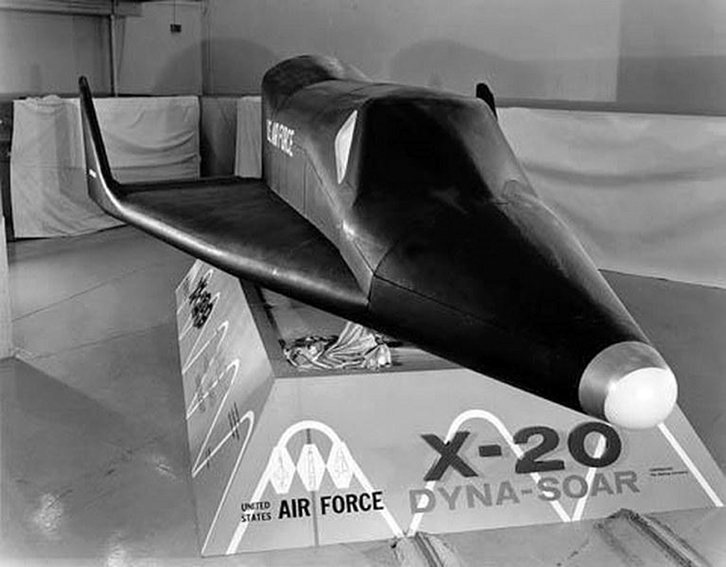
Such a capability was closely linked to the desire to have short notice access to space, specifically for military purposes. The realization arrived that the power requirements for take-off and orbit insertion associated with this ideal mode of operation were unobtainable. This led to proposals that relied on the brute force of rockets for the first stages of operations, thereby limiting the ‘short notice’ aspect.
The argument was made that these efforts eventually resulted in the Space Shuttle; however, whether the record
of 135 flights over a period of 30 years met this desire to have ‘short notice access’ or not is questionable. Instead, the Space Shuttle, with all of the spacecraft’s incredible achievements, was a cumbersome way to access space.
This article discusses some of the many proposals for spaceplanes that have been advanced over the years but have never seen the light of day.
United States
X-20 Mock-Up
Records claim that the United States commenced the Dyna Soar project on October 14, 1957, a mere 10 days after the launch of Sputnik-1.
On that day, the United States Air Force (USAF) issued what must be seen as preliminary directives for a maneuverable spaceplane. The concept was to a certain extent a follow-on from earlier studies undertaken for the USAF as well as for NASA under a variety of project names that included Hywards, 118P, Brass Ball and Bomi.
The project, with the military designation X-20, was an attempt to combine the best features of two approaches: high speed flight in space and the capability to return to Earth with airplane-like control.
In March of 1958, eight aerospace companies submitted proposals and in June of that year, Boeing, as well as a Bell/Martin consortium, were awarded contracts for further studies into the project. By December 9, 1959, it was obvious that the Bell/Martin proposals relied heavily on unproven technology and Boeing was awarded a development contract for their Model 844.
The craft that was then under development by the company was a delta-winged glider and was to be rocketed into space by a powerful booster. Once in orbit, the pilot would be able to fly to any point on the globe at speeds of more than 27,000 km/h. When the pilot would have completed the mission, the craft would be flown back into the atmosphere and then land at an appropriate airfield of the pilot’s choice.
The term Dyna Soar is derived from 'dynamic' and ‘soaring,' meaning that the vehicle was to use centrifugal force and aerodynamic lift. Centrifugal force was to sustain the craft at orbital speeds when flying just fast enough to off-set the pull of the Earth's gravity. The aerodynamic lift would be given by the wings and would be used for flight in the atmosphere.
By 1961, the design was frozen and the Air Force formally ordered 10 production vehicles. The craft had a span of 6.17 meters a length of 10.77 meters, a height of 2.44 meters and an empty weight of 4912 kg—there was no propulsion system.
At that point of time, the plan was to fly seven scale models of the X-20 on top of Scout rockets into sub-orbital trajectories to test high speed flight as well as thermal protection. Further plans were for air drop tests that would commence in 1963 using a B-52 mothership. These flights, which would be unmanned as well as manned, would occur over Edwards Air Force Base in California.
In 1964, the first unmanned, sub-orbital flight was to take place while the first unmanned orbital flight was to occur in late 1965. After two such flights, the first manned orbital flight was scheduled for early 1966 after which flights at three months' intervals were planned. At that point in time, funds would then be made available for a total of 12 flights. All orbital flights were to be launched by a modified Martin Titan launch vehicle.
Further developments included the X-20A, to demonstrate reconnaissance and satellite inspection; X-20B, for anti-satellite missions and X-20X; and a larger version to test satellite interception and destruction.
In mid-1961, the government, in the embodiment of the Secretary for Defense McNamara, began to question the project and delays crept into the program, leaving only the pure space flight aspect. When it appeared that this project was adequately being met by the other crewed space projects of the US, on December 10, 1963, the entire Dyna Soar project was canceled.
By that time Boeing had built a full scale mock-up of the Dyna Soar and some material for production had been cut, although no construction had been started. Additionally, the Air Force had selected a number of potential pilots for the project's initial phase and subsequent 'operational' phase. This selection had taken place in three groups on March 15, April 20, and October 22, 1962. Once the program was officially canceled, most of these pilots went back to other duties, although some eventually became astronauts.
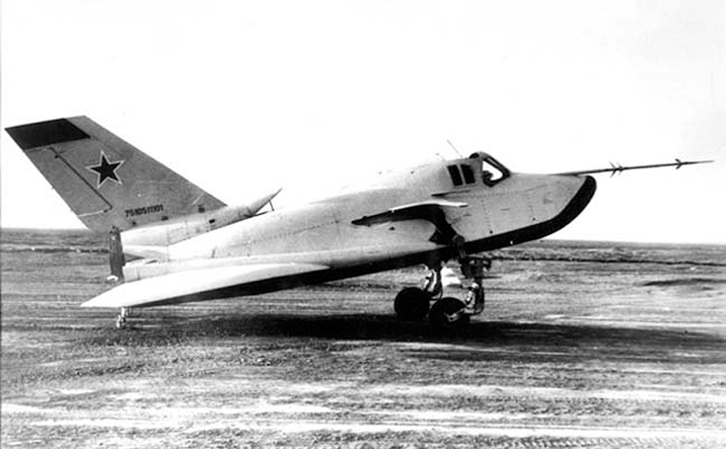
USSR's Mikoyan Spiral.
USSR
Mikoyan Spiral
The USSR undertook studies not dissimilar to the US Dyna Soar and the Mikoyan design bureau developed a proposal for a winged spaceplane that would be launched on top of a Soyuz launch vehicle.
Identified as Spiral, the program was canceled but was resurrected in 1974 as a development program associated with the Buran Shuttle vehicle. As part of this project, MiG built the MiG 105-11 vehicle, with a length of 8.5 meters and a span of 6.4 meters with accommodation for a single crew member. The vehicle was fitted with a Koliesov RD-36 jet engine and made a first flight on October 11, 1976. The eighth and final flight was in September of 1978. The plan was to have the craft fitted with an orbital rocket engine.
France & ESA
In the 1980s, the European Space Agency started planning for a re-usable spaceplane to provide independent crewed access to space. The plan envisaged a spacecraft that could take three astronauts on missions of from 30 to 90 days duration in space.
Hermes commenced as a pure French project but, with increasing costs, the development became a European effort, with substantial funding added by Germany in November 1987.
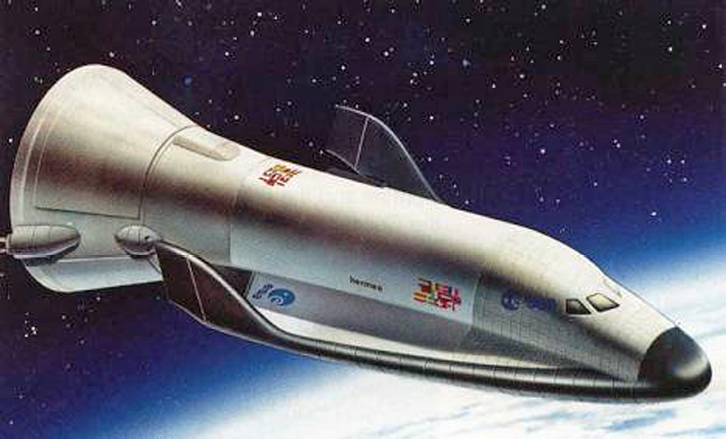
The European Hermes vehicle.
In 1984, Hermes was seen as a small mini-space shuttle that would consist of two modules: a spaceplane that could carry four to six astronauts plus a 4500 kg payload in the cargo bay as well as a cone shaped Resource Module at the rear of the spacecraft that would be abandoned before re-entry. The spaceplane was anticipated to be able to conduct at least 30 flights without requiring major servicing.
Payloads to be returned to Earth could be contained in a small payload bay, but most experiments were included in an expendable pressurized supply module, equipped with a docking port that was mounted to the base of the glider.
As the Hermes was too heavy to be launched by the existing Ariane 4 launcher, the Ariane 5 vehicle was developed to launch this vehicle from Kourou. Hermes would also land at Kourou, with alternative landing sites at Fort de France Island, Bermuda, or Istres in southern France.
The mission envisioned flights to the proposed European remote sensing Polar Platform (PPF), flights to ESA’s Man-Tenden Free Flyer (MTFF) Station and flights to the proposed Columbus module for the Freedom Space Station.
The original Ariane 5 proposal envisaged mating the Ariane booster stage with a new upper stage burning liquid oxygen and hydrogen, which would have boosted the payload capability to more than 15 tons. Eventually, Ariane 5 became, however, a totally new vehicle with an even larger capability.
Over the same time period, the Hermes was reduced in size to a crew of three and a 3,000 kg pressurized payload with a length of 15.51 meters and a span of 10.57 meters. The cargo bay had a diameter of 2.70 and a length of 7.70 meters.
In April 1985, Dassault-Breguet and Aerospatiale submitted designs for Hermes to the French national space agency CNES and, in October of 1985, CNES awarded a contract to Aerospatiale with some assistance required from Dassault-Breguet. The cost was expected to be about $1.9 billion, including $1.1 billion for development and construction of two vehicles.
By the time ESA took over the project in November 1987, the cost was expected to be $4.25 million, including two qualifications flights, as well as $3.36 million for the development of the Ariane 5 launch vehicle. France was to absorb 45 percent of the cost while Germany was to fund 30 percent of the program.
But by the time the first phase of the Hermes development was completed in November of 1991, ESA decided to have a year long "reflection" period in order to review and reconsider their plans to build its own space shuttle and space station or, if new partners could be found to share the cost and development of the craft.
In the new European political arena, ESA and Russia agreed to cooperate on future launchers as well as a replacement for the Mir space station. Both Russia and ESA then joined NASA in the International Space Station program and the need for a European crew transport system disappeared, as both Russia and the US had existing capabilities that did not require expansion. Accordingly, ESA decided to cancel the Hermes development in November of 1992.
A ‘reduced’ Hermes X-2000 unmanned technology demonstrator was briefly considered but was canceled at the same time—$2 billion had been spent on the Hermes project.
Had the Hermes program continued, the first unmanned mission would occurred in 2002 with the first crewed mission taking place in 2003. The program would have been managed by an industrial company named Euro Hermesspace, with the French companies Aerospatiale and Dassault-Breguet controlling 51.6 percent, Germany’s DASA 33.4 percent and Italy’s Aeritalia 15 percent.
Japan
HOPE
In 1986, Japan initiated the development of the H2 Orbiting Plane (HOPE), a re-usable spaceplane that would carry as many as four astronauts to the Freedom Space Station in which Japan had agreed to take part. This was one of Japan’s two contributions to the Freedom Space Station operations, the other being the Japanese Experiment Module (JEM) which eventually evolved into the Kibo module of the International Space Station (ISS).
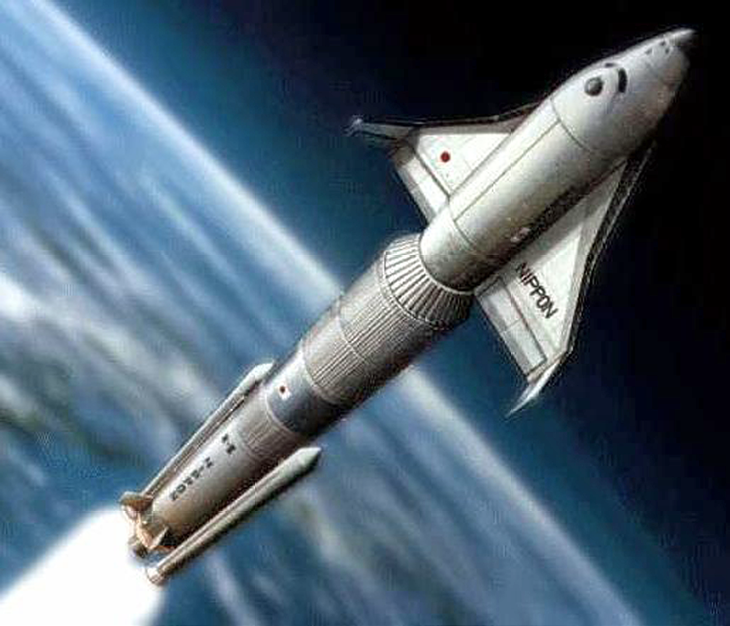
Japan's HOPE vehicle.
HOPE was to be used to ferry astronauts and supplies to the space station and was to be developed in piloted and automatic versions that would have a span of 12.00 meters and a length of 16.50 meters, which would carry a 2,000 kg payload. Operations were envisaged to start in 2000. The spaceplane was to be launched via the H2 launch vehicle that was still under development at this time. The returning spaceplane was to land on the Aeon air field on Christmas Island in the Pacific Ocean.
As a first step in the development, the intention was to build a sub-scale prototype identified as the H-2 Orbiting Plane. Experimental (HOPE-X) was to be used for flight testing and systems validation before the larger HOPE spaceplane was constructed. The HOPE-X was to have a span of 9.75 meters and a length of 15.24 meters and, like HOPE, was to be launched by the H2 rocket
As part of the development of the HOPE-X, Japan’s space agency (JAXA) undertook several test sub-projects.
The experimental Orbital Re-Entry EXperiment (OREX) ballistic re-entry vehicle, also known as Ryusei, tested various communications systems, heating profiles and heat shielding components. The vehicle had a mass of 870 kg and was launched on February 3, 1994, with the first H2 launch vehicle and was placed in an orbit of about 6,830 km. After one orbit, the vehicle re-entered Earth’s atmosphere and collected data during that re-entry that was transmitted prior to a central Pacific splashdown.
The second test vehicle was the Hypersonic Flight Experiment (Hyflex), which was placed into a sub-orbital trajectory with a J-1 launch vehicle on February 12, 1996. The 1,050 kg lifting body vehicle tested the reentry technology. Hyflex reached an altitude of 110 km and then executed a glide back into the Earth’s atmosphere. The craft's parachutes deployed successfully; however, the craft broke away from the retaining harness and dropped into the sea approximately 250 km northeast of Ogosawana Island.
The Automatic Landing Flight Experiment (Alflex) tests demonstrated low-speed aerodynamic and landing systems. The vehicle, with a span of 3.78 meters and a length of 6.10 meters, was dropped from a helicopter flying at high altitude. Thirteen flights were conducted at Woomera, Australia, from July 6 to August 15, 1996, and each test was successful.
By 1997, HOPE-X had developed into an unscrewed cargo spacecraft with an automatic approach and landing system and able to deliver 3,000 kg of cargo to what by then was the International Space Station (ISS). HOPE-X would have made the operations of the ISS independent of the Russian Progress cargo transfer spacecraft and the first flight was envisaged in 2004.
But by 1999, the H2 launch vehicle, after encountering many difficulties, was canceled by Japan. After a first flight on February 3, 1994, with Orex, another six flights were completed, with the seventh, and last one, failing on November 15, 1999. After this experience, the further development concentrated on the simplified and lighter H2A. As a consequence, HOPE-X was canceled in 2000 and had never flown.
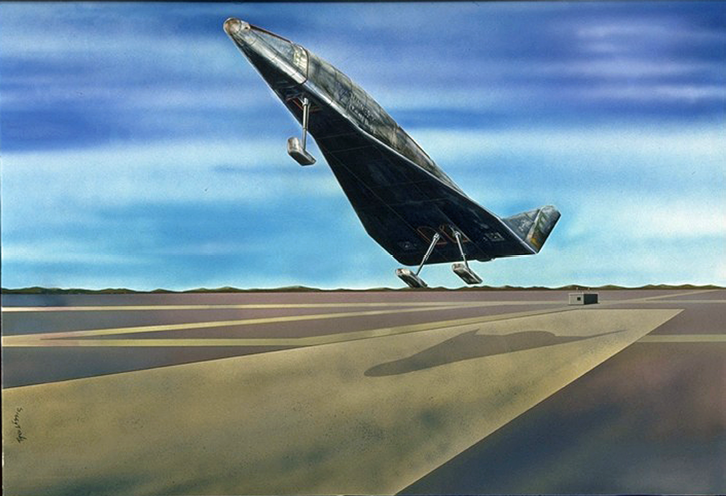
Development of the HOPE spaceplane continued and by 2003 consideration was given to air-launching the vehicle with an aircraft. But Japan’s economic conditions, as well as the urgency given to establishing a series of observation satellites to track the North Korean nuclear efforts, led to the cancellation of HOPE in 2003.
Germany
During the 1930s and 1940s, German-Austrian Eugen Sänger conceived and developed the design of a spaceplane that would fly at a speed of Mach 10 and at an altitude of 160 km. This eventually led to his 1944 design of an antipodal bomber that could be launched to suborbital velocity, skip off the upper atmosphere to deliver a bomb load on target and then return back to the launch site.
After the war, Sänger worked in France before returning to Germany for further research on winged shuttle designs as a professor at the Technical University of Berlin—he died in 1964. Sänger’s final design was the Raumtransporter (RT)-8-01. The RT-1 to RT-7 designs represented a range of alternative lifting-body and winged configurations advanced by Sänger, but these were never built except for the air-dropped models.
In 1961, the German Messerschmidt-Bölkow-Blöhm (MBB) started further development of the RT-8 as a crewed spaceplane
RT-8
The RT-8 configuration involved a sled that was powered by a steam rocket. This sled would propel the first and second stages of the spaceplane on a 3 km track to a release velocity of 900 km/h. The first and second stages were fitted with liquid oxygen/hydrogen fueled rocket engines.
After release from the sled, the first stage would take the vehicle to an altitude of 60 km, where separation would occur, after which a glide back to the launch site would transpire.
The second stage would then fly to an altitude of 300 km.
The first stage had a shoulder mounted delta wing, providing the necessary lift at those high speeds and allowing the vehicle to fly back toward a landing. The vehicle had a span of 31 meters and a length if 31 meters and would have carried a crew of two and capable carrying a 500 kg payload.
By 1965, MBB had abandoned the concept of a sled and, after briefly considering a subsonic air release from a large aircraft, gave consideration to a vertical take-off, two stage concept vehicle identified as RT-8-02. By 1969, MBB abandoned further development.

To date, there has been no spaceplane developed that meets the ‘single-stage-to-orbit' (SSTO) and horizontal-takeoff-horizontal-landing launch requirements. However, there can be little doubt that designers will continue to research this ideal means to access space.
Jos Heyman, a retired accountant, specializes in the dissemination of information on the scientific exploration and commercial application of space for use by educational as well as commercial organizations. Jos has more than 40 years of experience in the historical aspects of astronautics.


